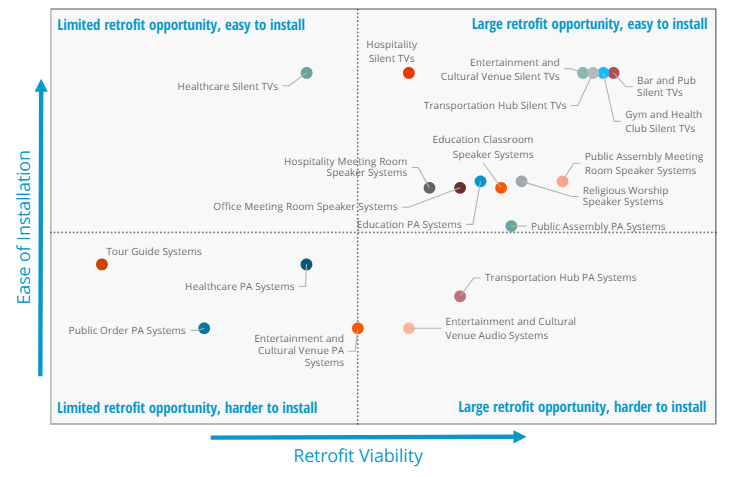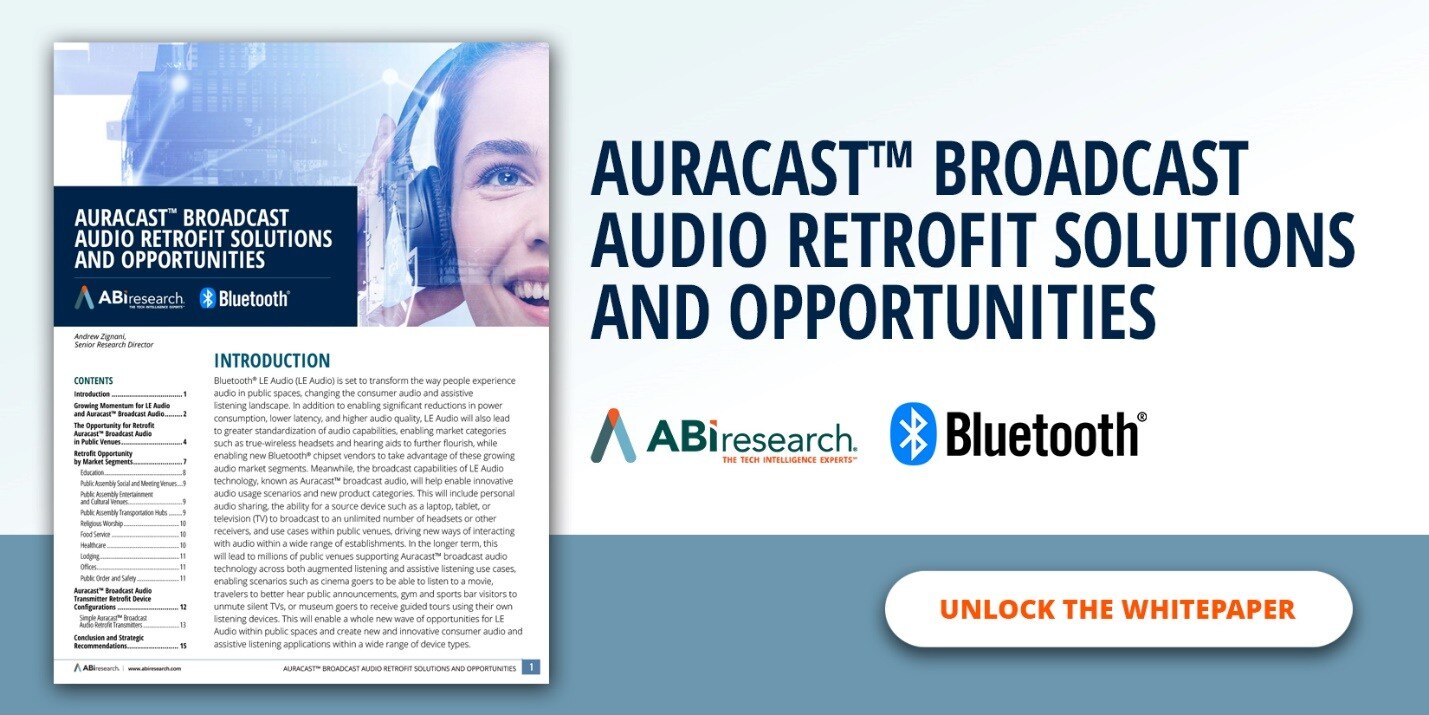One of the most exciting capabilities of Bluetooth® Low Energy (LE) audio is Auracast™ broadcast audio. Have you ever had trouble hearing a flight announcement at the airport? Or wish you could hear the audio on a muted TV while using a treadmill at the gym? Auracast™-supported transmitters can address pain points like these by sending direct-to-ear audio signals to an unlimited number of nearby users. Not only will Auracast™ unlock new audio-sharing experiences for mainstream consumers, but the technology will improve the quality of life for hearing aid users. With Auracast™, people who require assistive listening devices can tune into a low-latency broadcast using their own personal device instead of needing a Radio Frequency (RF)-capable device provided to them from the venue.
Let’s take a look at some notable use cases and examples of Bluetooth® Auracast™, the flurry of market activity from Bluetooth® device manufacturers aiming to support the revolutionary audio technology.
Chart 1: Total Auracast™ Broadcast Audio Deployments
World Markets: 2024 to 2030

(Source: ABI Research)
What Is Auracast™?
Auracast™ is a Bluetooth® audio broadcasting technology that allows users to share audio streams with others, unmute televisions, tune into Public Address (PA) systems, and more. The opportunities with Auracast™ are numerous, allowing consumers to watch the same movie with their own earbuds, watch TV in a public space without distraction, and never again miss an important announcement at a sports venue or transportation hub.
Both the transmitter (TV, PA system, etc.) and a receiving Bluetooth® 5.2 or later device (smartphone, laptop, tablet, etc.) must support Auracast™ for it to work. According to the Bluetooth Special Interest Group (SIG), users can connect to an Auracast™ signal in three ways:
- Search for an Auracast™ broadcast the same way you already search for a local Wi-Fi network
- Scan a QR code
- Tap on your device like how you tap-to-pay for products
The Retrofit Opportunity for Auracast™ Broadcast Audio
The rise of Bluetooth® LE Audio and Auracast™ broadcast audio presents a valuable chance for Bluetooth® solution providers to offer retrofit solutions. These low-cost systems, including transmitters, adapters, and dongles, allow public venues to upgrade their existing audio infrastructure without needing a full overhaul.
Retrofitting allows venues to provide enhanced audio experiences, especially for those who rely on assistive listening devices. This transitional technology helps bridge the gap between current systems and the fully integrated Auracast™ solutions of the future.
Key Use Cases for Auracast™
As support for LE Audio and Auracast™ has taken off relatively rapidly for receiver devices, there’s a huge opportunity for Bluetooth® solution providers to deploy Auracast™ in public venues. These simple, low-cost retrofitted deployments unlock a range of Auracast™ use cases, such as augmented listening, silent TV screens, multi-language support, and tour systems.
Enhanced Audio for Public Announcements
Auracast™ can transform audio in public spaces like airports, cinemas, and lecture halls by enabling visitors to receive PA announcements directly to their Bluetooth® headsets or hearing devices. This solution enhances audio clarity, especially in noisy environments, making it valuable for hearing aid users and the general public. Auracast™ also acts as an Assistive Listening System (ALS), which is crucial for venues striving for accessibility without expensive, specialized equipment.
Silent TV Screens in Public Spaces
In places like airports, restaurants, pubs, gyms, and hotels, silent TV screens can be equipped with Auracast™ dongles to broadcast audio directly to users’ Bluetooth®-enabled devices. Whether visitors want to tune into a news channel, a sports event, or background music, this system transforms passive TV viewing into an interactive experience. It’s a low-cost alternative to upgrading all televisions in public venues, providing instant access to audio without any added infrastructure.
Multi-Language Support for Events
Venues such as conference centers and meeting rooms often need to cater to a diverse audience. Auracast™ allows these venues to broadcast multiple audio streams in different languages, enabling attendees to listen in their preferred language using their own Bluetooth® headsets. This eliminates the need for bulky, expensive translation headsets and receivers, making multi-language support easier to deploy and manage.
Improved Guided Tours
Tourist attractions, museums, and convention centers can improve their guided tours by incorporating Auracast™. Visitors can use their own Bluetooth® devices to hear the tour guide, eliminating the need for additional headsets. Auracast™ can also integrate with smartphones, making it easier for venues to offer a tour system that’s more accessible and cost-effective, without the need for specialized devices.
Figure 1: Retrofit Auracast™ Broadcast Audio Opportunity by Viability and Ease of Installation

(Source: ABI Research)
Applying Auracast™ to Public Venues
Auracast™ broadcast audio solutions can be deployed in a variety of public and private venues, enabling enhanced accessibility and improved audio experiences across multiple sectors. By leveraging existing infrastructure, venues can implement low-cost Auracast™ solutions to improve the visitor experience.
Education
In schools, colleges, and universities, Auracast™ can enhance lecture halls, classrooms, and auditoriums by integrating with existing PA systems. This improves both student and teacher communication while providing assistive listening solutions.
Healthcare
Hospitals and clinics can retrofit PA systems and waiting room TVs with Auracast™, ensuring visitors hear important announcements and can access TV audio directly through their headsets, which improves patient comfort and experience.
Religious Worship
Places of worship, including churches, mosques, and temples, can use Auracast™ to improve sermon delivery by connecting the PA system to users' hearing aids and Bluetooth® headsets. This setup is a cost-effective alternative to installing complex hearing loop systems.
Public Assembly Social and Meeting Venues
Libraries, community centers, convention centers, and senior centers can retrofit their PA systems and meeting room speakers with Auracast™ to provide better audio for public announcements, presentations, and events.
Entertainment and Cultural Venues
In theaters, cinemas, and museums, Auracast™ can broadcast movie audio, stage performances, or tour guide audio directly to visitors’ devices. Sports arenas can retrofit their audio systems, allowing fans to hear game commentary or important announcements.
Lodging and Hospitality
Hotels, motels, and dormitories can offer better audio experiences for guests by retrofitting in-room TVs and lobby TVs with Auracast™ transmitters. Guests can tune in using their own devices, which is especially beneficial for those with hearing loss.
Public Order and Safety
Police stations, courthouses, and other public order buildings can enhance communication in courtrooms and meeting rooms by integrating Auracast™ into existing audio systems. This ensures everyone can clearly hear proceedings and announcements, improving accessibility and security.
Food Service
Restaurants, cafes, bars, and sports venues can retrofit silent TVs with Auracast™ broadcast audio, allowing patrons to listen to sports, news, or other programming directly through their own Bluetooth® devices.
Growing Auracast™ Support for Consumer Devices
Bluetooth® LE Audio and Auracast™ have gained significant momentum since the release of LE Audio specifications in July 2022. A number of chipset vendors, such as Qualcomm, Broadcom, MediaTek, Airoha, Nordic Semiconductor, and NXP, have developed LE Audio-ready silicon.
Hearing aid vendors Cochlear Unlimited and GN Hearing are two notable vendors capitalizing on the Auracast™ opportunity. In November 2022, the U.S. Food and Drug Administration (FDA) approved its Cochlear Nucleus 8 Sound Processor, marking the onset of Auracast™-supported cochlear implant sound processors. More recently, GN Hearing announced Auracast™ functionality for its ReSound Nexia hearing aids and its TV-Streamer + device in late 2023.
Hearing aid suppliers are not alone in the Auracast™ space, with a number of device manufacturers supporting the technology in smartphones, tablets, PCs, notebooks, and TVs. Widespread support for Auracast™ broadcast audio is years away, yet there are encouraging signs for the market. Besides some device manufacturers sending firmware updates to enable Auracast™ for existing products, big-name consumer brands are all-in on the Bluetooth® upgrade. Samsung is a standout example, providing Auracast™ compatibility in Android 13 for its Galaxy 23 and Fold series, enabled through its One UI 6 (and higher) update. The South Korean electronics company also supports Auracast™ for its true wireless earbuds, Samsung Galaxy Buds2 Pro, and the Neo QLED 8K and MICRO LED TV series.
Why Auracast™?
ABI Research estimates that more than 60 million venues worldwide could potentially benefit from Auracast™. Due to its ease of deployment/use and ability to enrich the audio experience, Auracast™ is set to transform numerous market verticals, including education, public assembly, religious worship, food service, healthcare, lodging, offices, and public safety. These venues heavily rely on PA systems and other audio streaming services that can easily and cheaply be retrofitted to support Auracast™.
Auracast™ broadcast audio technology offers public venues and device manufacturers a unique opportunity to enhance audio experiences for everyone. The retrofit market provides a cost-effective, scalable solution for venues looking to upgrade their systems without major overhauls. As Auracast™ technology becomes more integrated, the potential for growth across multiple sectors is immense, enabling venues to deliver personalized, accessible audio in ways never before possible.
You may wonder why not retrofit assistive and augmented listening transmitters with other existing listening technologies like Radio Frequency (RF) or Infrared (IR). For example, RF assistive listening can provide similar benefits as Auracast™, such as multi-channel audio streaming, ease of setup, and low costs. However, RF assistive listening requires a venue to provide visitors with dedicated hardware that can connect to a hearing aid or hearing device. Auracast™, on the other hand, allows venue visitors to simply use their own devices to tune in to an audio stream. The convenience of such a setup makes a more compelling case for retrofitting existing audio transmitting devices with Auracast™ broadcast audio. Furthermore, the growing number of end-user devices supporting Bluetooth® LE Audio and Auracast™ makes the audio technology an even more logical choice going forward.
Download ABI Research’s Auracast™ Broadcast Audio Retrofit Solutions and Opportunities whitepaper, which offers a comprehensive evaluation of how Auracast™ can be retrofitted to existing audio systems to enrich visitor experiences in public venues.
 Andrew Zignani, Senior Research Director at ABI Research
Andrew Zignani, Senior Research Director at ABI Research
As Senior Research Director for ABI Research’s Strategic Technologies team, Andrew Zignani conducts research into the rapidly changing wireless connectivity market, with a particular emphasis on market forecasts and qualitative insight covering Bluetooth, Wi-Fi, 802.15.4, Near Field Communications (NFC), HaLow, WiGig, and other emerging wireless standards and protocols. Andrew also writes reports on the technological evolution and long-term prospects for wireless connectivity technologies, particularly as they increasingly target new verticals across the Internet of Things (IoT).






